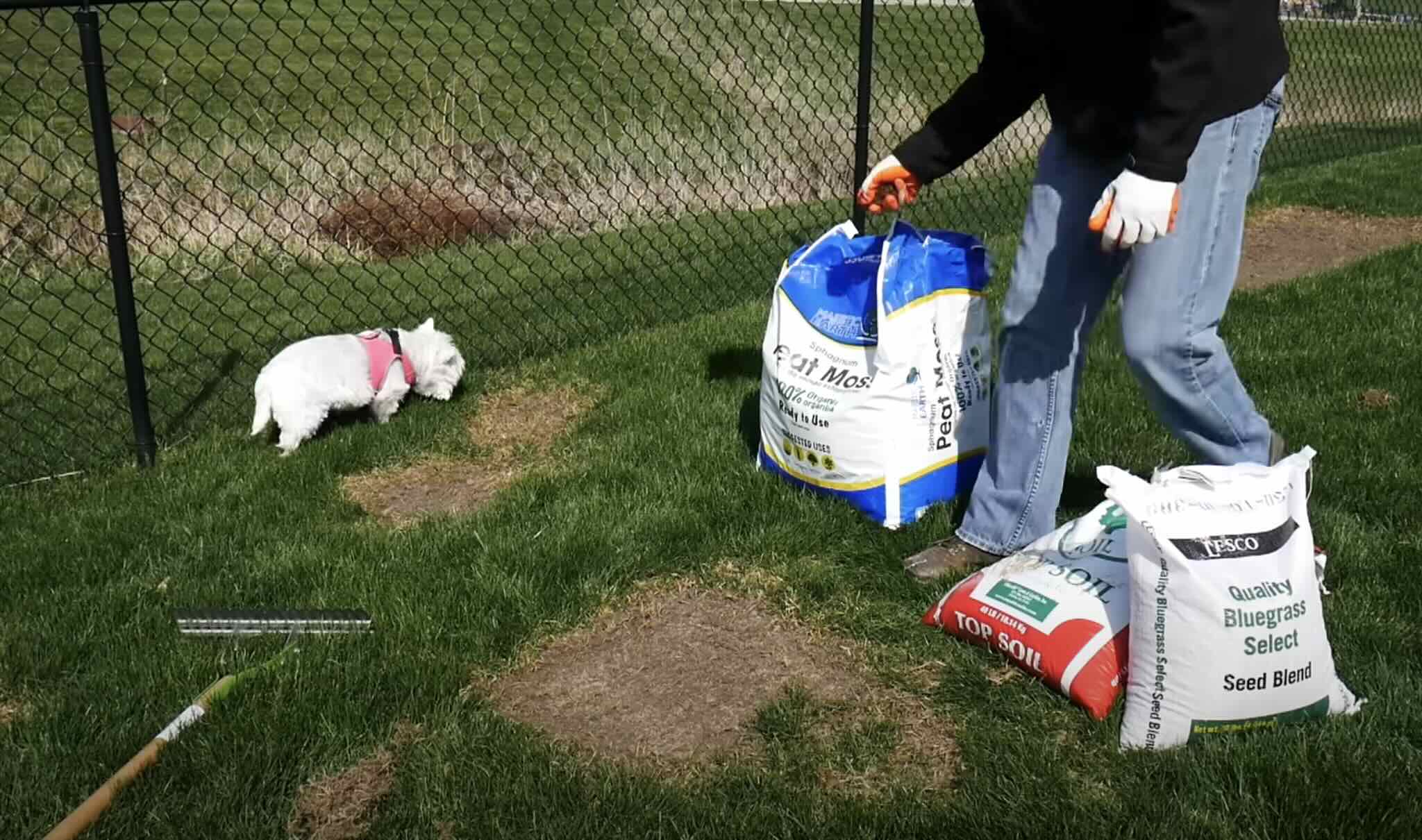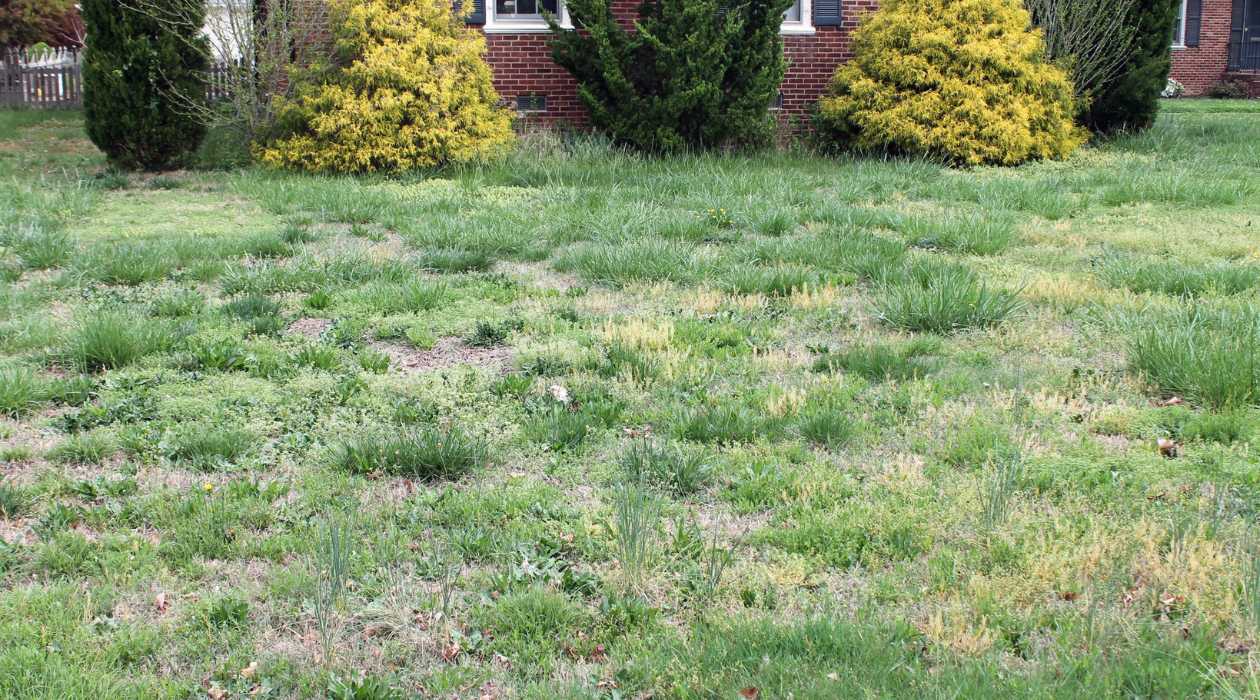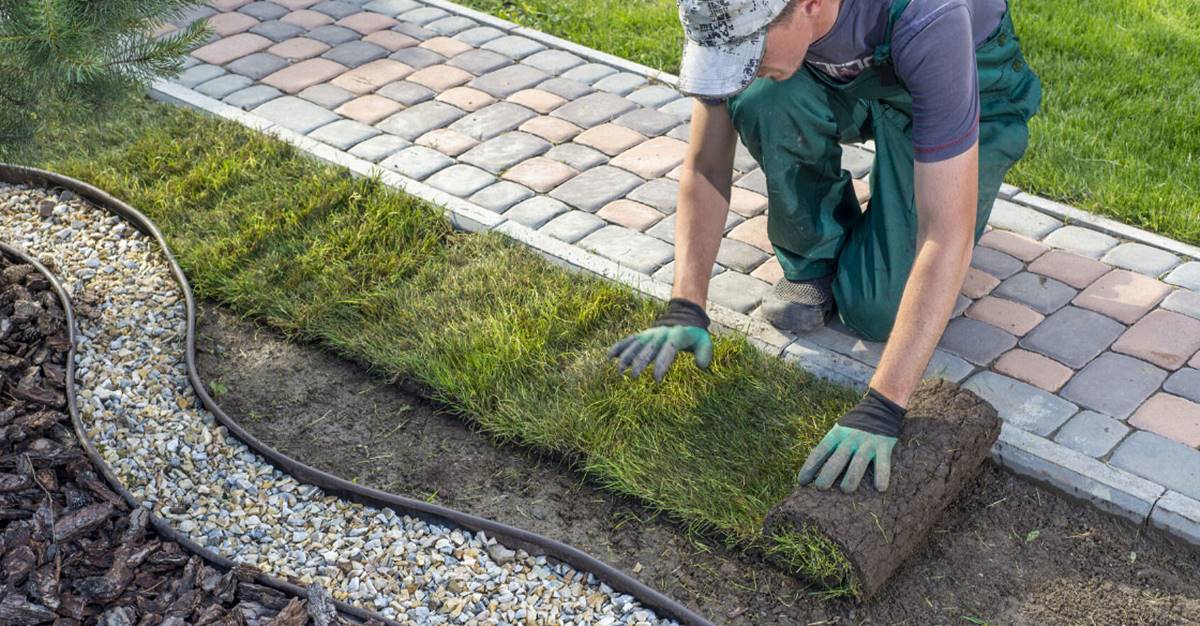Home>Gardening & Outdoor>Landscaping Ideas>How To Restore Grass In Yard


Landscaping Ideas
How To Restore Grass In Yard
Modified: February 18, 2024
Learn effective landscaping ideas for restoring grass in your yard. Discover expert tips for rejuvenating your lawn and enhancing your outdoor space. Achieve a lush, green yard with our proven techniques.
(Many of the links in this article redirect to a specific reviewed product. Your purchase of these products through affiliate links helps to generate commission for Storables.com, at no extra cost. Learn more)
Introduction
Introduction
Welcome to the ultimate guide on how to restore grass in your yard! A lush, green lawn not only enhances the beauty of your outdoor space but also provides a welcoming environment for outdoor activities and relaxation. However, maintaining a healthy lawn requires effort and attention, especially when faced with issues such as bare patches, thinning grass, or other forms of damage.
In this comprehensive guide, we will explore the step-by-step process of restoring grass in your yard, from assessing the damage to selecting the right grass seed, preparing the soil, seeding the lawn, and providing essential maintenance tips. Whether you're a seasoned gardener or a novice enthusiast, this guide will equip you with the knowledge and techniques needed to revive your lawn and transform it into a vibrant and resilient carpet of greenery.
So, roll up your sleeves, grab your gardening tools, and let's embark on a journey to rejuvenate your yard and create a picturesque landscape that you can be proud of. With a little dedication and the right approach, you'll soon be enjoying a revitalized lawn that enhances the charm of your outdoor space. Let's dive in and discover the secrets to restoring the beauty of your grassy haven.
Key Takeaways:
- Assess your lawn’s condition, choose the right grass seed, prepare the soil, and follow proper seeding and maintenance techniques to restore a lush, vibrant lawn.
- By investing time and effort in restoring your lawn, you can enjoy the transformation, embrace ongoing care, and share your newfound expertise with others to create a resilient and visually stunning outdoor space.
Assessing the Damage
Before embarking on the journey of restoring your grass, it’s crucial to assess the extent of the damage to your lawn. This initial step sets the stage for the subsequent actions you’ll take to revive the health and vibrancy of your yard. Here’s how to effectively evaluate the condition of your lawn:
-
Identify Problem Areas: Take a walk around your yard and carefully observe the grass. Look for bare patches, areas of thinning grass, or signs of discoloration and distress. These problem areas may be caused by various factors, such as heavy foot traffic, pet damage, insect infestations, diseases, or inadequate sunlight.
-
Examine Soil Quality: Assess the quality of the soil in different parts of your yard. Soil compaction, poor drainage, and imbalanced pH levels can contribute to the deterioration of grass. Use a soil testing kit to determine the pH level and nutrient composition of the soil, as this information will guide your soil preparation and seed selection.
-
Consider External Factors: Take into account external factors that may impact the health of your lawn, such as overhanging trees that create excessive shade, neighboring properties with aggressive weeds, or environmental stressors like drought or excessive rainfall. Understanding these influences will help you address the root causes of the damage.
By conducting a thorough assessment of the damage, you’ll gain valuable insights into the specific issues affecting your lawn. This knowledge will empower you to make informed decisions when choosing the appropriate grass seed, soil amendments, and maintenance practices to restore your grass to its former glory.
Choosing the Right Grass Seed
When it comes to restoring your lawn, selecting the right grass seed is a critical decision that significantly impacts the success of your efforts. Factors such as climate, soil type, sunlight exposure, and intended use of the lawn should guide your choice of grass seed. Here’s how to choose the most suitable grass seed for your yard:
-
Evaluate Climate and Hardiness: Consider your local climate and the hardiness zone in which you reside. Different grass species thrive in various climates, so it’s essential to choose a grass seed that is well-suited to the temperature and precipitation patterns of your region. Cool-season grasses, such as Kentucky bluegrass and fescue, are ideal for northern regions, while warm-season grasses like Bermuda grass and Zoysia grass thrive in southern climates.
-
Assess Sunlight and Shade: Determine the amount of sunlight and shade that different areas of your yard receive throughout the day. Some grass species, like fine fescues, excel in shady conditions, while others, such as Bermuda grass, require ample sunlight to flourish. Select a grass seed that matches the light exposure in each section of your lawn to ensure optimal growth.
-
Consider Intended Use: Think about how you plan to use your lawn. If you anticipate heavy foot traffic, opt for a durable grass variety that can withstand frequent use. For ornamental lawns or areas with minimal activity, prioritize aesthetics and choose a grass seed that yields a lush, fine-textured turf.
-
Soil Compatibility: Take into account the characteristics of your soil, including its drainage capacity, nutrient levels, and pH balance. Some grass species are more adaptable to specific soil conditions, so select grass seed varieties that align with the soil properties in your yard. Additionally, consider incorporating soil amendments to improve soil quality and create an optimal environment for grass growth.
By carefully considering these factors, you can narrow down the options and choose the most suitable grass seed for your lawn restoration project. Whether you prioritize resilience, aesthetics, or functionality, the right grass seed will lay the foundation for a thriving and resilient lawn that enhances the allure of your outdoor space.
Preparing the Soil
Before sowing the seeds for your new lawn, it’s essential to prepare the soil to create an optimal environment for grass germination and growth. Proper soil preparation sets the stage for healthy root development and ensures that the grass seedlings receive the necessary nutrients and moisture to thrive. Here’s a step-by-step guide to preparing the soil for your revitalized lawn:
-
Clear the Area: Begin by removing any debris, rocks, or existing vegetation from the area where you plan to sow the grass seed. Clearing the space creates a clean canvas for the new grass to take root and minimizes competition for resources.
-
Aerate the Soil: If the soil is compacted, use a garden fork or a core aerator to loosen the ground and improve air circulation. Aeration helps alleviate soil compaction, facilitates water penetration, and promotes the development of robust grassroots.
-
Address Soil Imbalances: Based on the results of a soil test, address any imbalances in pH levels or nutrient deficiencies by incorporating the appropriate amendments. Adding lime to raise the pH or elemental sulfur to lower it can optimize the soil’s acidity, while organic matter such as compost or well-rotted manure enhances nutrient levels and soil structure.
-
Level the Surface: Use a rake to level the soil surface, filling in low spots and breaking up clumps to create a smooth and uniform area for seeding. A level surface promotes consistent seed coverage and uniform germination, resulting in a visually appealing and even lawn.
-
Apply Starter Fertilizer: Prior to seeding, apply a high-phosphorus starter fertilizer to provide essential nutrients that support vigorous root establishment. This specialized fertilizer formulation encourages strong root development, enabling the grass seedlings to establish themselves more effectively in the prepared soil.
By meticulously preparing the soil, you create an environment that is conducive to successful grass establishment and long-term vitality. Investing time and effort in soil preparation sets the stage for a resilient and thriving lawn, ensuring that your grass seedlings have the best possible start in their journey to lush maturity.
One tip for restoring grass in your yard is to aerate the soil to improve air, water, and nutrient flow to the roots. This can help promote healthy grass growth.
Read more: How To Flatten Grass Yard
Seeding the Lawn
Seeding the lawn is a pivotal step in the process of restoring grass in your yard, and it requires careful attention to detail to ensure even coverage and robust germination. Whether you’re overseeding existing grass or establishing a new lawn, the following guidelines will help you achieve optimal results when sowing the grass seed:
-
Choose the Right Time: Select an appropriate time to seed your lawn based on the type of grass you’re planting and the climate in your region. Cool-season grasses are best seeded in early fall, while warm-season varieties thrive when sown in late spring to early summer. Timing your seeding efforts to coincide with favorable growing conditions sets the stage for successful germination and establishment.
-
Use the Correct Seeding Rate: Follow the recommended seeding rate for the specific grass species you’ve chosen. Using the appropriate amount of seed ensures adequate coverage and prevents overcrowding, allowing each seedling to access the resources it needs for healthy growth.
-
Employ Proper Seeding Techniques: Distribute the grass seed evenly across the prepared soil using a seed spreader or by hand broadcasting. After spreading the seed, lightly rake the soil to cover the seeds with a thin layer of soil, promoting good seed-to-soil contact for optimal germination.
-
Consider Overseeding: If you’re overseeding an existing lawn to fill in bare patches or revitalize thinning grass, mow the existing grass to a shorter height to facilitate seed-to-soil contact and ensure that the new seedlings receive ample sunlight and access to essential resources.
-
Protect and Water the Seeded Area: After seeding, gently water the area to provide moisture that supports germination. Consider covering the seeded area with a thin layer of straw mulch to retain moisture, prevent erosion, and protect the seeds from birds and other potential disturbances.
By following these guidelines, you can ensure that your grass seed is sown effectively, setting the stage for robust germination and the emergence of a healthy, vibrant lawn. With proper seeding techniques and attentive care, you’ll soon witness the transformation of your yard as the new grass seedlings take root and flourish.
Watering and Maintenance
After seeding your lawn, diligent watering and ongoing maintenance are essential to nurture the newly sown grass seed and facilitate its healthy establishment. By providing the right amount of water, implementing proper mowing practices, and addressing potential weed and pest issues, you can support the growth and resilience of your revitalized lawn. Here’s a comprehensive overview of watering and maintenance practices for your newly seeded lawn:
-
Establish a Watering Schedule: Keep the newly seeded area consistently moist by watering lightly multiple times per day, especially during the germination period. Avoid overwatering, which can lead to seed displacement and encourage disease, and aim to keep the soil surface consistently damp without becoming waterlogged.
-
Monitor Soil Moisture: Check the soil moisture regularly to ensure that the seeded area remains adequately hydrated. Adjust your watering frequency and duration based on weather conditions, taking into account factors such as rainfall and temperature to prevent the soil from drying out.
-
Practice Careful Mowing: Once the new grass reaches a height of approximately 3 inches, carefully mow the lawn, ensuring that the mower blades are sharp and set to the appropriate height. Avoid mowing too closely to prevent stress on the developing grass and allow the seedlings to establish strong root systems.
-
Address Weed and Pest Issues: Keep an eye out for weeds and pests that may threaten the health of your newly seeded lawn. Promptly address any weed infestations or pest problems, employing targeted control methods that minimize the impact on the developing grass while effectively managing unwanted intruders.
-
Apply Additional Fertilization: As the new grass matures, consider applying a balanced fertilizer to provide essential nutrients that support healthy growth and vitality. Choose a fertilizer specifically formulated for new lawns or seedlings to promote robust root development and overall resilience.
By adhering to these watering and maintenance practices, you can provide the care and attention needed to nurture your newly seeded lawn and encourage its development into a lush, resilient carpet of greenery. With consistent watering, vigilant maintenance, and proactive weed and pest management, you’ll pave the way for a thriving and visually stunning lawn that enhances the beauty of your outdoor space.
Conclusion
Congratulations on embarking on the journey to restore the beauty of your grassy haven! By following the comprehensive steps outlined in this guide, you’ve gained valuable insights into the process of rejuvenating your lawn and creating a vibrant, resilient outdoor space. As you conclude your lawn restoration project, it’s essential to reflect on the transformative journey you’ve undertaken and celebrate the progress you’ve made. Here are some key points to consider as you wrap up your lawn restoration endeavor:
-
Appreciate the Transformation: Take a moment to appreciate the transformation that has taken place in your yard. From addressing bare patches and thinning grass to nurturing new seedlings, you’ve played a pivotal role in revitalizing your lawn and enhancing its visual appeal.
-
Embrace the Care and Maintenance: Recognize the ongoing commitment required to maintain a healthy and vibrant lawn. Regular watering, attentive mowing, and proactive weed and pest management are essential components of nurturing your revitalized lawn and ensuring its long-term vitality.
-
Enjoy the Fruits of Your Labor: As your newly seeded grass matures and flourishes, take pleasure in the lush, green expanse that graces your outdoor space. Whether you’re hosting outdoor gatherings, relaxing in the sunshine, or simply admiring the beauty of your lawn, your efforts have created an inviting and picturesque landscape.
-
Share Your Knowledge: Consider sharing your newfound expertise with friends, family, or fellow gardening enthusiasts. Your firsthand experience in restoring your lawn equips you with valuable insights that can inspire and guide others who are seeking to rejuvenate their own outdoor spaces.
As you conclude this transformative journey, remember that the dedication and care you’ve invested in restoring your grass have laid the foundation for a resilient and visually stunning lawn. By embracing the principles of attentive maintenance and nurturing, you’ll continue to enjoy the beauty and allure of your revitalized outdoor haven for years to come. With a renewed sense of pride in your lush, green oasis, you can savor the rewards of your efforts and revel in the natural splendor of your vibrant, revitalized lawn.
Frequently Asked Questions about How To Restore Grass In Yard
Was this page helpful?
At Storables.com, we guarantee accurate and reliable information. Our content, validated by Expert Board Contributors, is crafted following stringent Editorial Policies. We're committed to providing you with well-researched, expert-backed insights for all your informational needs.















0 thoughts on “How To Restore Grass In Yard”